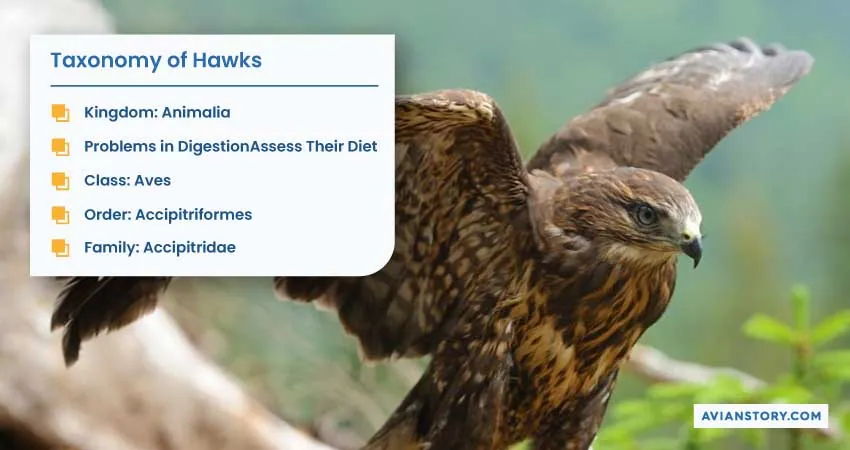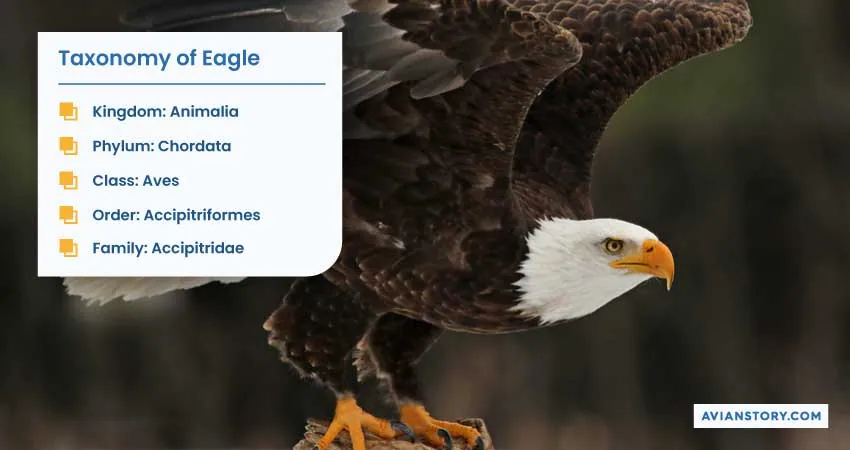Hawks Vs Eagles: The Ultimate Comparison
When birds of prey like hawks or eagles hunt down their prey, that majestic appearance is something to remember. Though these birds belong to the same family, they have a lot more differences than similarities.
Hawks are smaller than eagles in terms of length, height, and wingspan. Feather color is also different in these birds. Hawks have visible markings on feathers, but eagles don’t. And eagles have more grip strength, which they use to hunt larger prey.
We will do a detailed comparison of hawks vs eagles and talk about their characteristics, habitats, diet, conservation status, and more. On the other hand, it will be easier for you to identify these birds easily. Plus, you will learn their roles in the ecosystems. Let’s get started.
What Are Hawks and Eagles?
Here is a quick overview of both birds.
Definition of Hawks and Eagles
- Hawk: Hawks are medium-sized birds of prey, which means they hunt for food. These birds have a slender stature, which allows them to have swift motion. It helps hawks a lot while chasing their prey for hunting.
- Eagle: Eagles, on the other hand, are also birds of prey. But they are more muscular than the Hawks. Eagles have the heaviest beaks, which they use to rip their prey apart. And they use a swooping motion to attack the prey.
Common Characteristics of Both Species
As hawks hunt down primary animals as well as secondary animals, they are considered tertiary eaters. Hawks have very good eyesight, from where the phrase ‘hawk-eyed’ originates. See the Hawk Vision vs Human comparison to learn more about the hawks’ vision.
Eagles also have excellent eyesight, which they use to locate prey while soaring high in the sky. As tertiary eaters, eagles also live at the vertex of the food chain.
What Are the Main Differences Between Hawks and Eagles?

Let’s take a brief look at the key differences between these birds.
| Characteristics | Hawks | Eagles |
| Length | 22-27 inches | 36 inches |
| Wingspan | 4-5 ft | 6.5 ft |
| Weight | 2-4.5 pounds | 8-18 pounds |
| Feather Color | Gray or brown | Brown, gray, or golden |
| Grip Strength | 200 psi | 400 psi |
| Species | 250 | 74 |
| Lifespan | 15 years | 30 years |
Hawks and eagles are quite different in terms of size, lifespan, hunting techniques, and more. Here is a detailed comparison of these aspects.
Size and Weight
The first difference you will notice between hawks and eagles is their size. Hawks are about 22 to 27 inches long, depending on the species. And they have a wingspan of 4-5 ft. Hawk wings are a bit rounded toward the end. These birds weigh about 2-4.5 pounds.
On the other hand, eagles are pretty large. They can be about 36 inches in size and have a muscular body. So, their stance is more aggressive. Eagles have an average wingspan of 6.5 feet and weigh 8-18 pounds, depending on the species. Their wings are straighter than hawks.
Appearance
The body frame of hawks is lean. They commonly have gray or brown feathers on the back and white features under the belly. You will notice streaks or dark markings on their features.
These markings are more prominent near the necks. Their wings, legs, and tails may also have similar spots or bars. And their beaks are shorter compared to eagles. These beaks are mostly dark colored. Remember, the color and markings can vary depending on the species.
Eagles are commonly brown, gray, or golden in color. They don’t have distinctive streaks on their features. Their beaks are much larger than hawks and usually bright yellow. These hooked beaks have a higher grip strength.
Strength and Dietary Patterns
As birds of prey, both birds have an almost common diet. Hawks usually hunt small rodents like mice, chipmunks, squirrels, etc. They also eat small birds, reptiles, and even insects. Remember, the diets of different hawk species can vary. Check the hunting behavior and diet of Cooper’s hawks.
Eagles have a similar diet, but they also tend to hunt waterfowl, snakes, and even fish. This is common for eagles living near water sources. Due to a smaller body and less grip strength, hawks go after small prey. They have a grip strength of about 200 psi, whereas eagles have a grip strength of about 400 psi.
Hawks can pick up to 4 pounds, and eagles can lift about 20 pounds. So, eagles usually prey on larger animals. For example, eagles may sometimes attack small goats, deer, or geese.
Flight and Hunting Techniques
Hawks generally wait in high trees for their prey. Once they are ready to attack, they swiftly fly toward the prey and chase it down. Their wings form a V-shape during flights. But, Do Hawks Hunt at Night? No, hawks are diurnal, which means they are active during the day.
Eagles typically soar high in the sky. When they spot the prey from a height, they generally swoop down at a high speed and hunt it down. These birds can fly at about 120-150 miles per hour.
Lifespan
Hawks have a shorter lifespan than eagles. So, how long do hawks live? They live about 15 years, while eagles have an average lifespan of 30 years.
How Are Hawks and Eagles Classified Taxonomically?
Hawks have about 250 varieties. Among these varieties, most hawks fall under one of two groups. One is true hawks, and the other is buteo hawks. Sparrowhawks, sharp-shinned hawks, and goshawks are considered true hawks. The ferruginous hawk is the largest hawk in the world.
Buteo hawks are called buzzards all over the world except in the United States. Hawks belong to the Accipitridae family of the Order Accipitriformes. Many may also confuse hawks with falcons. Check Hawks vs Falcons to learn their differences.
Eagles also belong to the same family. But they have much fewer species variations. You may find about 74 species of eagles. Among them, harpy eagles, martial eagles, sea eagles, crested eagles, and booted eagles are common. The giant Philippine eagle is the largest species.
Taxonomy of Hawks

Here is the basic taxonomic classification of hawk:
- Kingdom: Animalia
- Phylum: Chordata
- Class: Aves
- Order: Accipitriformes
- Family: Accipitridae
- Species:
- Buteo jamaicensis – These are red-tailed hawks, and they are found in North America, Alaska, Canada, Panama, West Indies.
- Accipiter nisus – They are known as Eurasian sparrowhawks or just sparrowhawks. Male sparrowhawks can have bluish feathers on the back and orange on the belly.
- Buteo lineatus – Red-shouldered hawks are native to North America and Central Mexico. These are a bit smaller than average.
- Accipiter cooperii – Cooper’s hawk is a common species in North America, Canada, and Mexico.
Taxonomy of Eagle

Here is the basic taxonomic classification of the eagle:
- Kingdom: Animalia
- Phylum: Chordata
- Class: Aves
- Order: Accipitriformes
- Family: Accipitridae
- Species:
- Haliaeetus leucocephalus – Bald eagles are native to North America.
- Aquila chrysaetos – Golden eagles are widely distributed in the Northern Hemisphere.
- Harpia Harpyja – Harpy eagles are neotropical and mostly found in America and Papua New Guinea.
- Polemaetus bellicosus – Martial eagles are a large species and mostly found in sub-Saharan Africa.
Geographical Distribution
Hawks are commonly found in forested areas, where they can hide and hunt easily. You will commonly find them in Central America, South America, Europe, and Asia. Many ask, do hawks migrate? Well, some hawks can migrate in the winter months, but these are mostly short-distance migrations.
Eagles are more widespread than hawks. You may find them everywhere in the world except Antarctica. But most of the eagle population is in Africa and Asia.
General Habitats
Though the habitats of different hawk species can vary, they generally choose open areas. So, you will commonly see them in deserts, rainforests, and mountain cliffs. Spotting hawks in prairies or close to lakes is also common. And they are spread around the continents.
Eagles also have diverse habitats. But you will mostly find them in high-altitude regions, such as mountains. Some species are also familiar with urban habitats.
How Do Hawks and Eagles Communicate?
You may have heard hawks screeching in real life or movies. These screeching sounds are hoarse, and you might hear them from a distance. But eagles have a high-pitched vocalization pattern that might sound like chirps.
Body Language
Depending on whether a hawk is aggressive or submissive, it can show different body language. For example, their heads will be upright, and the features will be standing if the hawk is aggressive or wants to defend its territory. But when the hawk is calm or submissive, it will lower its head and feathers.
Eagles also use different postures to communicate. For example, if an eagle is relaxed, it may perch on one foot or stretch the foot. But when the eagle is aggressive or defensive, it will show head snaking, panting, or similar behaviors.
What Role Do Hawks and Eagles Play in Their Ecosystems?
Hawks and eagles have diverse diets. So, they hunt down a lot of animals in the wild and play roles as predators. This plays a great role in their native ecosystems, where they control the population of small rodents, snakes, birds, and insects.
Role as Prey
Besides being predators, hawks and eagles sometimes become prey. Though they live high in the food chain, hawks can be hunted down by other hawks that are larger. You may also ask what animal eats a hawk. Well, eagles, raccoons, owls, wolves, etc., can eat hawks.
Eagles also face predators like alligators, great horned owls, lions, bears, etc. So, they are pretty important in their ecosystems.
How Are Hawks and Eagles Portrayed in Culture and Symbolism?
These birds are common elements in many folklore and symbolisms.
Hawks in Folklore and Symbolism
Due to their powerful appearance, hawks are symbolized as strength and freedom in many communities, like Native Americans. In many folklore, hawks are considered divine creatures.
Eagles in Folklore and Symbolism
You may have seen eagles in many monograms at the national level. This bird symbolizes might, beauty, royalty, etc. Romans considered eagles the messengers of Jupiter. In some indigenous cultures, eagle feathers are used as the highest form of honor.
What Are the Major Threats to Hawks and Eagles?

These birds face three major threats that are causing their population to drop. Here is a quick overview.
Environmental Challenges
The natural habitat of hawks and eagles is getting constricted day by day. As a result, these birds are being compelled to shift their habitats. But are hawks endangered? Find it later.
Human Interference
From wiping off forestlands to using pesticides, humans have a direct impact on the nesting and dietary patterns of these birds. As a result, the habitats and food sources for these birds have been narrowed down.
Climate Change
Even though hawks and eagles can survive in deserted environments at high temperatures, global climate change is affecting many of their species. Those species usually live in cold climate areas, and they are being affected by climate change.
What Conservation Efforts Are in Place for Hawks and Eagles?
Before knowing the efforts, let’s check the conservation status of these birds.
Not all species of hawks are on the endangered or threatened list of IUCN. However, it is evident that the hawk population of some species is declining. For example, Red Goshawks are on the endangered list of IUCN.
The same is true for the eagle population. Some species of eagles, such as the Harpy Eagles, are on the vulnerable list.
Conservation Efforts
To protect the population of hawks and eagles, countries have taken many steps. For example, Red-tailed Hawks are protected under the Migratory Bird Treaty Act. Golden Eagles and Bald Eagles are also protected birds in the USA.
Role of Rehabilitation Centers
Multiple organizations are working as rehabilitation centers for these raptors. They provide treatment, care, and rehabilitation for hawks, eagles, falcons, etc. Due to the impeccable role of these centers, the population of most hawk and eagle species is still stable.
Conclusion
We discussed the differences and similarities between hawks and eagles in terms of physical appearance, taxonomy, diet, hunting techniques, and more. These differences can help you in identification of hawk and eagle identification. Plus, you learned the role of these birds in the ecosystems and folklore.
With an enlightened mind and detailed information about these birds, it will be easier for individuals and organizations to extend conservation efforts. Continuous research and conservation efforts will ensure hawks and eagles maintain a stable population in their natural ecosystems.
